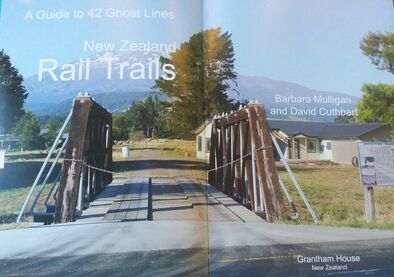 The frontispiece of the book that was published
by Grantham House. Photo Barbara Mulligan
The frontispiece of the book that was published
by Grantham House. Photo Barbara Mulligan
We are Barbara Mulligan and David Cuthbert, both retired after many years in various public service and not-for-profit roles. David sailed recreationally in New Zealand's coastal waters for many years, and has a wide interest in maritime matters generally. David is currently a Board member of the NZ Rail & Locomotive Society, and chairs their Administration Committee. He is also a member of the Board of the NZ Ship & Marine Society.
A long-standing interest in small ports and all associated maritime matters led to an interest in land-based connections between ports and inevitably to the role of branch railway lines connecting to ports.
When driving round New Zealand visiting small ports our constant companion was a copy of Exploring New Zealand’s Ghost Railways by David Leitch and Brian Scott, researched and written during the first half of the 1990s. Some of the directions in the Leitch/Scott publication caused great frustration, being vague and lacking in detail.
Over time, access to new technology such as GPS and GIS, combined with the simplicity of Google Earth, seemed to provide an opportunity to track and trace the railway lines in a much more detailed manner, and the idea of writing an updated version of the Leitch/Scott publication became much more than a response to frustration. Recognition that over time the landscape was inevitably changing and rail heritage was rapidly disappearing focused our thoughts on writing a new and somewhat different book on the subject of New Zealand's “ghost railways”.
During the intervening years some old railway lines had been converted to alternative use – as vintage/steam railways, as cycling/walking trails, or as a tourism venture adopting new technology or where “rail carts” were operating on old branch lines. Information about all these is readily available online and doesn’t need repeating. Some routes had been “mothballed” pending decisions as to their ultimate fate. With these factors in mind we developed criteria for including (and excluding) branch lines.
A long-standing interest in small ports and all associated maritime matters led to an interest in land-based connections between ports and inevitably to the role of branch railway lines connecting to ports.
When driving round New Zealand visiting small ports our constant companion was a copy of Exploring New Zealand’s Ghost Railways by David Leitch and Brian Scott, researched and written during the first half of the 1990s. Some of the directions in the Leitch/Scott publication caused great frustration, being vague and lacking in detail.
Over time, access to new technology such as GPS and GIS, combined with the simplicity of Google Earth, seemed to provide an opportunity to track and trace the railway lines in a much more detailed manner, and the idea of writing an updated version of the Leitch/Scott publication became much more than a response to frustration. Recognition that over time the landscape was inevitably changing and rail heritage was rapidly disappearing focused our thoughts on writing a new and somewhat different book on the subject of New Zealand's “ghost railways”.
During the intervening years some old railway lines had been converted to alternative use – as vintage/steam railways, as cycling/walking trails, or as a tourism venture adopting new technology or where “rail carts” were operating on old branch lines. Information about all these is readily available online and doesn’t need repeating. Some routes had been “mothballed” pending decisions as to their ultimate fate. With these factors in mind we developed criteria for including (and excluding) branch lines.
SELECTION CRITERIA
To be included a branch line had to meet the following criteria:
Vintage or steam railways operating on portions of branch lines which are described have been referenced within and/or at the end of the relevant description e.g. Weka Pass Railway in the Waiau Branch description, Pleasant Point Railway and Museum in the Fairlie Branch description.
All decisions about which branch lines have been included, and those which have been excluded, were made by the authors, who have attempted to apply the selection criteria objectively and accurately.
To be included a branch line had to meet the following criteria:
- It had been operated by New Zealand Rail or its predecessors at some time.
- There is reasonable access to historic relics and viewpoints, and remnants of the railway (bridge piles, cuttings, embankments, heritage aspects) are still available for viewing.
- Lines which although partially re-developed for use by cyclists and walkers as a cycle trail have extensive sections which have not been so converted.
- Private lines which once serviced forestry, sawmills, gold and coal mines.
- Lines redeveloped as dedicated rail trails or for other users, such as Rotorua Railcarts.
- Lines restored and being used by vintage steam railway groups.
- Mothballed lines under consideration for reopening or developing significant alternative use.
- Lines which have been almost completely built over, are short and lack interesting features, and have not operated for many years.
Vintage or steam railways operating on portions of branch lines which are described have been referenced within and/or at the end of the relevant description e.g. Weka Pass Railway in the Waiau Branch description, Pleasant Point Railway and Museum in the Fairlie Branch description.
All decisions about which branch lines have been included, and those which have been excluded, were made by the authors, who have attempted to apply the selection criteria objectively and accurately.
